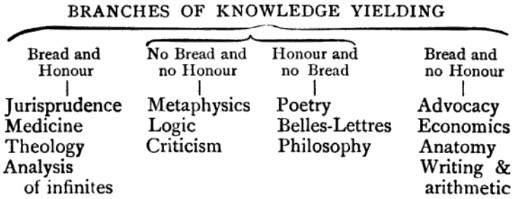A pleasing puzzle by Eric LeVasseur:
PI × R2 = AREA
If each letter in this expression (but not the exponent 2) is replaced with a corresponding digit, the resulting equation will be valid. What are the digits?
A pleasing puzzle by Eric LeVasseur:
PI × R2 = AREA
If each letter in this expression (but not the exponent 2) is replaced with a corresponding digit, the resulting equation will be valid. What are the digits?

07/17/2024 UPDATE: Several readers point out, correctly, that carbon is hardly the only elemental “chemical word” — indeed, some elements can be spelled in multiple ways. I’ve assembled this list from multiple contributions:
ArSeNiC ArSeNIC
AsTaTiNe
BiSmUTh BISmUTh
CArBON CaRbON
CoPPEr COPPEr
IrON
KrYPtON
NeON
OGaNeSSON OGaNEsSON
PHoSPHoRuS PHOSPHoRuS PHOsPHoRuS PHoSPHORus PHOSPHORuS PHOsPHORuS
SiLiCoN SiLiCON SILiCON SILiCoN
SiLvEr SILvEr
TeNNeSSINe TeNNEsSiNe TeNNEsSINe
TiN
XeNON XeNoN
TiN is even a valid compound, titanium nitride.
Of these Borgmann had found arsenic, carbon, iron, neon, phosphorus, silicon, and xenon when he wrote in 1974, “surely the most unusual is CARBON which can be factored into elements not including itself.” But that property wasn’t unique even within his limited list, as can be seen above.
Many thanks to readers Gareth McCaughan, Catalin Voinescu, and Eric Harshbarger for writing in about this.

Now, are not those still full of their old carnal nature who ask us: ‘What was God doing before he made heaven and earth? For if he was idle,’ they say, ‘and doing nothing, then why did he not continue in that state forever — doing nothing, as he had always done? If any new motion has arisen in God, and a new will to form a creature, which he had never before formed, how can that be a true eternity in which an act of will occurs that was not there before? For the will of God is not a created thing, but comes before the creation — and this is true because nothing could be created unless the will of the Creator came before it. The will of God, therefore, pertains to his very Essence. Yet if anything has arisen in the Essence of God that was not there before, then that Essence cannot truly be called eternal. But if it was the eternal will of God that the creation should come to be, why, then, is not the creation itself also from eternity?’
— Augustine, Confessions

In 1977, on receiving a package of insect specimens from a colleague, entomologist Arnold Menke exclaimed, “Aha, a new genus!” His colleague Eric Grissell responded “Ha” doubtfully. Menke was proven right and named the species, an Australian wasp, Aha ha. He ordered a custom registration plate for his car bearing the same phrase. Further odd names.

In Scranton, Pennsylvania, Washington crosses Delaware.
Suppose that each country on Earth has a colony on the moon and that we want to draw maps on which each nation’s territory receives a consistent color. How many colors would we need?
In 1980 Thom Sulanke showed that we might need as many as nine (above), but it’s possible that a particularly challenging map would require more than that. The problem remains unsolved.
In his Reflections, Georg Christoph Lichtenberg mentions a friend who divided human endeavor into four classes:


During the severe frost of February 1895, a stream of water overflowing Scotland’s Almond Aqueduct began to freeze to the River Almond 120 feet below. Over the course of three nights the mass grew upward until river and bridge were connected by a continuous pillar of ice, the largest such formation on record at the time.
“When the sun shone upon the giant mass,” observed the Strand, “the iridescence was beautiful, and people came from miles around to look at it.”
(Jeremy Broome, “Freaks of Frost,” Strand 12:12 [December 1896], 738-746.)

quisquous
adj. difficult to deal with or settle
quillet
n. a verbal nicety, a subtle distinction
aggiornamento
n. the act of bringing something up to date to meet current needs
irenic
adj. fitted or designed to promote peace
The survivors of the Titanic were picked up by the English passenger steamship Carpathia, which conveyed them to New York. This presented a delicate problem to the Social Register. “In those days the ship that people travelled on was an important yardstick in measuring their standing, and the Register dutifully kept track,” notes Walter Lord in A Night to Remember (1955). “To say that listed families crossed on the Titanic gave them their social due, but it wasn’t true. To say they arrived on the plodding Carpathia was true, but socially misleading. How to handle this dilemma? In the case of those lost, the Register dodged the problem — after their names it simply noted the words, ‘died at sea, 15 April 1912’. In the case of those living, the Register carefully ran the phrase, ‘Arrived Titan-Carpath, 18 April 1912’. The hyphen represented history’s greatest sea disaster.”

On Easter Saturday 1921, pharmacologist Otto Loewi dreamed of an experiment that would prove that the transmission of nerve impulses was chemical rather than electrical. He scribbled down the idea and went back to sleep, then discovered the next morning that he couldn’t read the note.
That day, he said, was the longest of his life. Fortunately, the dream returned to him that night, and this time he went immediately to the laboratory. Thirteen years later he received the Nobel Prize for discovering the role of acetylcholine as an endogenous neurotransmitter.